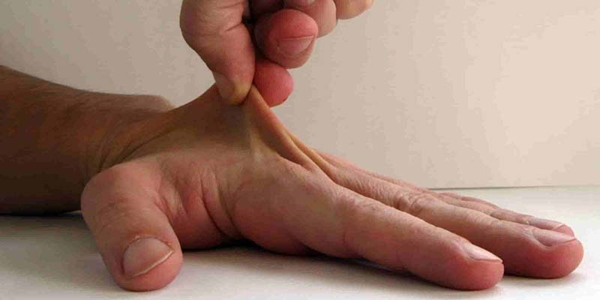23 Signs You Grew Up with Ehlers-Danlos Syndrome
Ehlers-Danlos Syndrome (EDS) is a connective tissue disorder that manifests through a variety of physical symptoms, which can significantly interfere with daily life. These symptoms arise from inherent weaknesses in connective tissues, showcasing various issues, including joint hypermobility, delicate skin, and unconventional scarring.
Ehlers-Danlos Syndrome (EDS) is a connective tissue disorder that manifests through a variety of physical symptoms, which can significantly interfere with daily life. These symptoms arise from inherent weaknesses in connective tissues, showcasing various issues, including joint hypermobility, delicate skin, and unconventional scarring.
Joint Hypermobility
Joint hypermobility is defined as the ability to move joints beyond the typical range of motion. This characteristic is prevalent among those with EDS, seen in an overwhelming majority of patients. While this flexibility can initially appear advantageous, it considerably increases the risk of injuries as individuals constantly struggle with the mechanics of movement.

Frequent Dislocations and Sprains
Joint instability in EDS can largely be attributed to the laxity of connective tissues. This laxity leads to a higher frequency of dislocations and sprains, as the joints often fail to maintain stability. The ongoing recurrence of these injuries complicates physical activity and raises concerns about long-term damage.
Soft, Stretchy Skin
Individuals with EDS often experience soft, stretchy skin, a direct result of connective tissue defects. This unique characteristic allows for unusual flexibility, as skin can be stretched beyond normal limits without pain. However, this increased elasticity also heightens vulnerability to skin injuries and bruising.
Easy Bruising
Another significant symptom of EDS is easy bruising, which stems from the fragility of blood vessels. The vascular issues associated with EDS mean that even minor contact can result in bruises, often appearing without significant trauma, leaving individuals and observers confused about the cause.
Chronic Joint Pain
Chronic joint pain is a prominent issue for those with EDS, necessitating specialized strategies for pain management. This pain is closely tied to structural instability within joints and may continue after injuries, adding to the complexity of living with the disorder.
Wounds Heal Slowly
Individuals with EDS experience prolonged healing times due to impaired collagen production. As a result, wounds may take longer to close, which underscores the importance of careful management to minimize the risks of complications and infections that could arise from slow recoveries.
Hyper-elasticity of Skin
Hyper-elastic skin is yet another notable feature of EDS, allowing for remarkable adaptability. While this trait can be intriguing, it also poses practical challenges as it raises the risk of skin tears and other injuries due to increased elasticity.

Velvety Skin Texture
Individuals living with EDS often describe their skin as possessing an unusual velvety texture. This unique characteristic may enhance the skin's appearance but also suggests underlying vulnerabilities that require special care to prevent injury and maintain skin health.
Scarring Issues
Scars resulting from injuries in EDS patients are distinctive, often appearing wide, thin, or discolored. The atypical nature of these scars can lead to significant psychological impacts, as individuals may struggle with self-esteem and body image issues stemming from their visible scars.
Daily Life Impact - Activities, Fatigue, and More
Ehlers-Danlos Syndrome significantly impacts daily life, with symptoms manifesting in both physical and mental challenges for individuals.
Difficulty with Physical Activities
The instability and pain related to EDS make physical activities particularly difficult and exhausting. Tasks like walking, standing for extended periods, or performing simple household chores can become overwhelming and often require adaptations or assistance from others.
Frequent Fatigue
Chronic fatigue is a frequent complaint among individuals living with EDS. Fluctuations in energy levels lead to ongoing exhaustion as the body continuously copes with discomfort, rendering even minor tasks feel monumental.
Frequent Pain Flare-ups
Pain flare-ups are not uncommon and can be triggered by activities, weather changes, or stress. These unexpected episodes often inhibit participation in favorite activities or social gatherings, leading to emotional distress and avoidance of situations that might provoke discomfort.
Trouble with Posture and Balance
Maintaining proper posture and balance can be challenging for those with EDS. The weakness in connective tissue may obstruct their ability to stand upright effectively, leading to falls or injuries that can affect their confidence and mobility over time.
Reduced Range of Motion
The limited range of motion in joints means that many individuals with EDS find it difficult to engage in exercises, leading to a more sedentary lifestyle. This lack of physical activity can compound health issues in the long run.
Sensitivity to Temperature Changes
Many individuals with EDS experience heightened sensitivity to temperature variations. Sudden temperature changes can exacerbate discomfort, driving many to seek controlled environments that further limit their active engagement in daily life.
Emotional and Psychological Effects of Ehlers-Danlos Syndrome
Living with Ehlers-Danlos Syndrome (EDS) extends beyond physical manifestations, inciting a complex web of emotional and psychological challenges that can hinder quality of life.
Anxiety About Injuries
The constant risk of injuries fosters substantial anxiety in those with EDS. The fear of dislocations or chronic pain signifies an ever-present concern, transforming routine activities into potential sources of stress.
Constant Need for Medical Care
Individuals with EDS often find themselves in a cycle of extensive medical care, requiring relationships with various healthcare providers to address their unique needs. Navigating this system can breed frustration and dependency as they advocate fiercely for their health.
Frustration with Lack of Diagnosis
An all-too-common experience for those living with EDS is the frustration stemming from misdiagnosis or delayed diagnosis. Such setbacks can elicit feelings of confusion and hopelessness while searching for medical professionals who recognize and validate their condition.
Feeling Different from Peers
Social interactions can prove challenging for those with EDS, as they often feel isolated in their experiences. This perceived difference can hinder their ability to develop connections and foster a longing for acceptance in social environments dominated by physical activity.

Body Image Concerns
Visible symptoms of EDS can significantly impact an individual's body image. This distortion of self-perception, fueled by attributes such as skin fragility and unusual physical features, can lead to low self-esteem and further complicate social interactions.
Mental Fatigue from Managing Symptoms
The rigorous effort to manage ongoing symptoms can result in mental fatigue, diverting focus from other important aspects of life. This perpetual cognitive load can lead to burnout, diminishing the overall quality of life for individuals.
Fear of Long-Term Complications
Underlying fears regarding potential long-term complications associated with EDS often loom large in their consciousness. Concerns about future health issues can heavily influence their overall mental well-being, leaving individuals anxious about the uncertainties of their health journey.
Coping with Invisible Illness
EDS is frequently classified as an invisible illness, complicating the understanding of symptoms within social contexts. This invisibility can lead to misunderstandings, creating a gap between personal experiences and societal perceptions that deepen the challenges faced by affected individuals.